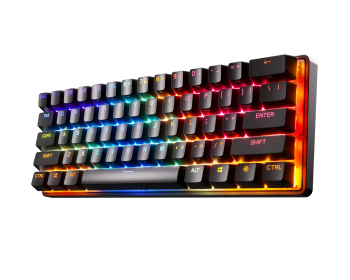Let's explain what the difference in our OmniPoint 2,0 technology is and how the Apex Pro Mini can get you the win you want.
The Keyboard Speed Wars
In the words of a twelve-year-old who beat me (33) in Call of Duty last night “#$@# ur to slow. get guud, old man.” This individual tapped into an important aspect of competitive gaming, being fast means the difference between a win and a loss. For us to understand how to beat this child prodigy, we are going to have to better understand keyboards, switches and how they work.
Switches: The Main Weapon in Speed
The "fastest" keyboards use the most advanced switches. The switch is the component underneath a keycap, it registers when you press the key down. Switch speed is improved in two basic ways: by shortening the distance that a key needs to travel until it electronically registers a keypress (called actuation by keyboard nerds and keystroke registration point by normies), and by speeding up the response time once a keypress is made.
So the keyboard with switches with the lowest possible actuation will typically be the fastest. Most mechanical and optical switches have a fixed actuation point, typically ranging between 1mm to 2mm.
Not having to travel far is what makes keys insanely sensitive. This is a great benefit for competitive players who need an advantage. But not everyone finds it easy to type on an ultra-fast, ultra-sensitive keyboard at all times. Thankfully, you can have it any way you want.
What is Keyboard Actuation?
Nowadays, there are mechanical switches that allow the user to change their actuation point – so we don’t have to be trapped in super-sensitive gaming mode at all times. When it comes to analog optical switches, those create the registration signal depending on how much a beam of light is broken. This results in an adjustable actuation ranging between 1.5mm to 3.6mm.
However, OmniPoint switches use magnetic sensors to detect the position of a keystroke at all times. Once the key moves to the designated position, the registration signal is generated. This allows for actuation customization usually between 0.4mm to 3.6mm (which is what our OmniPoint 1,0 achieved).
OmniPoint switches have the smooth and linear feel of red mechanical switches. Adjusting the actuation point affects when the keyboard registers the keypress, but not how the key physically feels under your fingers. Each key travels the same distance when bottoming out at any actuation point.
So now with my new Apex Pro Mini, OmniPoint switches and the power of magnets, we should have everything needed to win.
The OmniPoint 2,0 Difference
With the Apex Pro Mini, SteelSeries has upgraded the OmniPoint switch. Now it’s even faster thanks to a lower actuation point of 0,2 and an improved firmware response time.
10x faster actuation, 11x faster response time, 2x more durable (vs mechanical switches)
50% faster actuation, 33% faster response time (vs OmniPoint 1,0)
Oh yeah, and we've tested our gaming keyboard against the competition.
OmniPoint switches allow each key to be adjusted to anyone's needs, even if they change during the day. Whether honing competitive skills and precision, spamming Twitch chat, or simply typing up an email, OmniPoint switches can be whatever you need them to be. From deliberate typo-free keypresses, to the new fastest actuation in the world, and everything in between, OmniPoint 2,0 is the next leap in mechanical switch technology.





